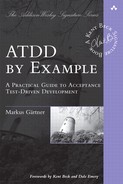Footnotes
Preface
1. Or, why did I use the particular arrangement of 1s and 0s that displays as “ATDD by Example” on your electronic device?
Chapter 2
3. A headless Selenium server runs the browser on a virtual server. With a headless Selenium server you can run all of your tests on a machine without a monitor.
Chapter 3
1. http://github.com/mgaertne/airport
Chapter 5
1. http://fitnesse.org/.FitNesse.UserGuide
Chapter 6
2. In the strict TDD world we could now philosophize whether I added something without having a failing test first. Having worked with FitNesse for the past three years or so, I am confident in knowing what I am doing here to the degree that I still feel safe and I am certain that I will use the last two definitions for the classpath and the test system later. Such arguments for a more pedantic application of TDD make sense in some contexts. In our context I will try to be pragmatic as long as I still feel safe with my assumptions, knowing that we can recover later if we lose that feeling.
3. Please note that an introduction to a Java IDE is beyond the scope of this book. There are great resources online for this. I used eclipse in the github project (http://github.com/mgaertne/trafficlights) to do that, but it should be straightforward for the other IDEs out there.
4. You should also check the FitNesse UserGuide on this: http://fitnesse.org/FitNesse.UserGuide.SliM.CustomTypes.
5. I hope you figured that we can run both the unit tests as well as the acceptance tests at this point.
Chapter 7
1. http://pragprog.com/articles/tell-dont-ask
Chapter 9
1. To save some trees I did not include an example—besides that, I refuse to mislead you by showing such a terrible example.
2. From Refactoring: Improving the Design of Existing Code [FBB+99] where Fowler and Beck speak of “Design smells” when something is not quite right in the underlying design. The term test smell appears also in xUnit Test Patterns: Refactoring Test Code [Mes07].
3. Camel-casing refers to a method to concatenate fluent text to a function name that does not include whitespace. For example, the text This is fun would yield thisIsFun as a function name.
5. In the literature this is often called Technical Debt. The term was coined in 1992 by Ward Cunningham: http://c2.com/cgi/wiki?TechnicalDebt
Chapter 11
1. Some testers stated this as their self-perception. However, in most cases I do not agree with this.
Chapter 12
1. http://johanneslink.net/projects/refit.jsp
Appendix C
1. http://code.google.com/p/robotframework/wiki/UserGuide
2. http://code.google.com/p/robotframework/wiki/TestLibraries
3. http://code.google.com/p/robotframework/wiki/Installation
4. http://robotframework.googlecode.com/hg/doc/python/PythonTutorial.html
